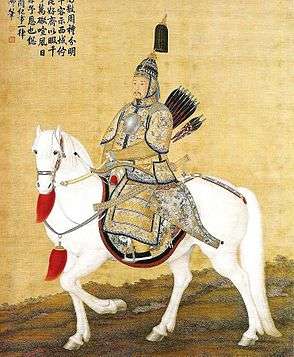High Qing era
The High Qing era (Chinese: 康雍乾盛世; pinyin: Kāng Yōng Qián Shèngshì; "Prosperous Age of Kangxi, Yongzheng and Qianlong") refers to the period between 1683 and 1839 during the Qing dynasty of China during which the empire's prosperity grew to new heights.[1] Set after the rule of the Ming dynasty, the High Qing saw China transformed into a commercial state with nearly twice the population of its predecessor, due to high political stability. Improvements in literacy also took place during this period.
.jpg)
Characteristics of the High Qing

The defining characteristics of the High Qing era were its new generation of rulers, commercialization, and territorial expansion.
New generation of emperors
Firstly, a new generation of emperors that combined the strengths of their culture in addition to a level of sinicization of the conquered cultures in order to combine assimilation and the retaining of their own cultural identity. This was initiated with the Kangxi Emperor who was in power at the initiation of the High Qing. As an emperor he elevated the status of the Qing empire through his passion for education in combination with his military expertise, and his restructuring of the bureaucracy into that of a cosmopolitan one. His son and successor, the Yongzheng Emperor ruled differently through more harsh and brutal tactics, but was also an efficient and unprecedented level of commitment to the betterment of the empire.[2] The last successful emperor of the High Qing was the Qianlong Emperor who, following in the footsteps of his father and grandfather, was a well-rounded ruler who created the peak of the High Qing empire. The unique and unprecedented ruling techniques of these three emperors, and the emphasis on multiculturalism[3] fostered the productivity and success that is the High Qing era.
Population growth
Another key characteristic of the High Qing period was the spike in population growth. After the Ming dynasty, population had dropped. However due to the commercialization of the state, new types of foods became available. Produce like sweet potatoes and corn became substitutes for rice in times of need, which enabled the population to grow without food shortages. This allowed for the population to double in the eighteenth century.
Territorial expansion
Additionally, the conquest of the western territories of the Mongols, Tibetans, and Muslims under the rule of the Qing were another factor of prosperity. Again, the skillful rule of the era’s emperors allowed for this success. Rule through chiefdoms in territories like Taiwan, allowed for the conquered peoples to retain their culture and be ruled by their own people while the Qing Empire still possessed the ultimate control and rule. These such ruling tactics created for little need or reason for rebellion of the conquered.[4] Another aspect of Manchu rule under the Qing Empire was rule within modern day China. The Mongols' attempt to rule may have failed because they attempted to rule from the outside. The High Qing Emperors ruled from within, enabling them to obtain and retain stable and efficient control of the state.
Commercial expansion
A heavy revival on the arts was another characteristic of the High Qing Empire. Through commercialization, items such as porcelain were mass produced and used in trade. Also, literature was emphasized as Imperial libraries were erected, and literacy rates of men and women both, rose within the elite class. The significance of education and art in this era is that it created for economic stimulation that would last for a period of over fifty years. [5]
Literacy
Another characteristic of the High Qing was rising literacy rates, not only among men, but women as well. Because men left the home more frequently during this era due to the commercialization of the trade industry, there was this conception that in order for the males for the family to succeed outside the home, women of the house needed to possess their own distinct morals and authority.[6] This meant that the most ideal mothers of elite families would be educated as well as their husbands, in reading and writing. The main purpose for this was to start teaching their sons to read and write as young as possible to better prepare them for the civil service examinations in their intended futures. The emphasis on women's education is a major change from that of previous eras, which further distinguishes the High Qing from that of other eras, and empires.
References
- Mann, Susan (1997). Precious Records. Stanford University Press. p. 20. ISBN 0-8047-2744-9.
- Rowe, William (10 September 2012). China's Last Empire. The Belknap Press of Harvard University Press. p. 66. ISBN 978-0-674-06624-3.
- Porter, Jonathan (4 February 2016). Imperial China 1350-1900. Rowman & Littlefield Publishers. ISBN 9781442222939.
- Hu, Minghui. "High Qing Society" HIS 140B, 31 January 2018, UCSC
- Hu, Minghui. "Settlement and Border Regions". HIS 140B, 9 February, 2018. UCSC
- Mann, Susan (1997). Precious Records. Stanford University Press. p. 15. ISBN 0804727449.